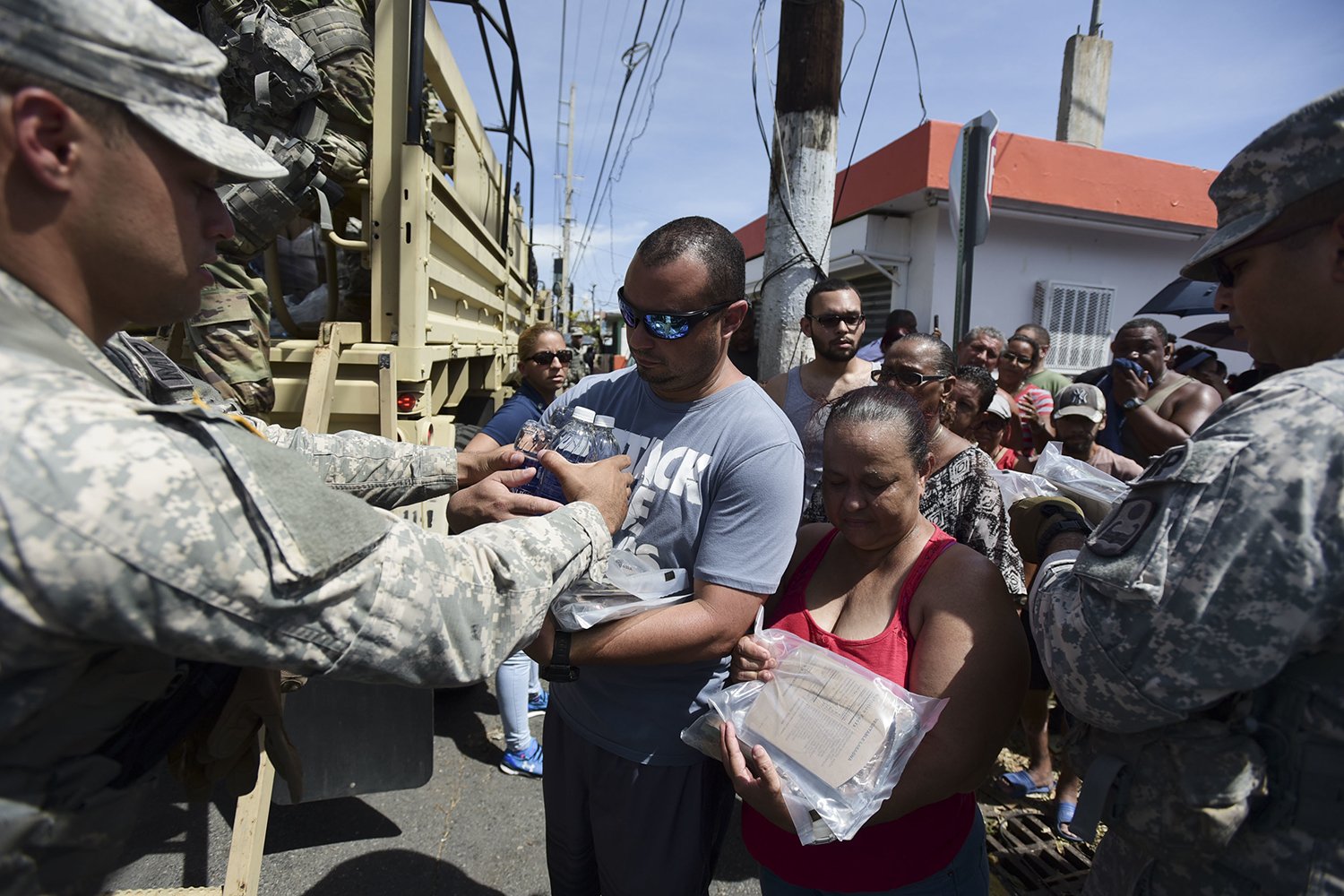 National Guardsmen arrive at Barrio Obrero in Santurce to distribute water and food among those affected by the passage of Hurricane Maria, in San Juan, Puerto Rico, Sunday, Sept. 24, 2017.AP Photo/Carlos Giusti
National Guardsmen arrive at Barrio Obrero in Santurce to distribute water and food among those affected by the passage of Hurricane Maria, in San Juan, Puerto Rico, Sunday, Sept. 24, 2017.AP Photo/Carlos Giusti
WASHINGTON, D.C. — It’s impossible to overstate the nightmare that Puerto Rico faces right now.
- 3.4 million American citizens are grappling with hunger, thirst, and lack of fuel, electricity or shelter.
- Almost half the population lacks potable drinking water and the situation could worsen before it gets better.
- The airport is broken down, sharply restricting the amount of aid that can come in and, conversely, the number of stranded passengers who can get out.
But Puerto Rico was already facing a nightmare before Maria even showed up — an economic one. The territory has been in recession since 2006, having never recovered from the Great Recession. It is also mired in a long-standing debt crisis that culminated in a historic bankruptcy over $70 billion in bonds, in May.
I asked Brad Setser, the former economic advisor to President Barack Obama who led the federal response to Puerto Rico’s debt crisis, about what the combination of economic and natural disasters means, and he put it in stark terms: There’s a chance Puerto Rico will never recover from this.
It’s all up to the federal government
“Will the island ever recover? I think it depends,” Sester said. “If Puerto Rico’s population decides that the US government doesn’t care and that they can get a better deal all around — better services, more federal benefits — by moving to Florida, they will move.”
“That could lead to a death spiral,” he said. “If folks lack electricity for many months I am not sure they will choose to rebuild in Puerto Rico without some additional support.”
When President Trump, who has already been criticized for his response to the crisis — because he was busy feuding with professional football players instead of rallying the country to help — finally turned his attention to the island he was quick to point out that its economy was in poor shape to begin with.
“Puerto Rico, which was already suffering from broken infrastructure & massive debt, is in deep trouble. It’s (sic.) old electrical grid, which was in terrible shape, was devastated,” Trump tweeted on Tuesday. “Much of the Island (sic.) was destroyed, with billions of dollars owed to Wall Street and the banks which, sadly, must be dealt with.”
I read that as the President saying Puerto Rico’s not getting off the hook — no matter what.
And this is where the Trump could see Hurricane Maria turn into his very own Hurricane Katrina. Airlifting food and generators is, of course, vital at this point, but not also immediately considering what the US can do to rebuild Puerto Rico’s economy will be devastating in the long-term.
Debt relief, Setser says, may be out of the federal government’s hands because Puerto Rico’s government owes money to private bondholders and some distressed debt funds.
“Congress doesn’t usually forgive debts owed to other people,” Setser said. “And Congress already has provided a bankruptcy-style process for restructuring Puerto Rico’s debts.”
There are things that can be done about it though. “What I do expect is that the oversight board will adjust the fiscal plan so that there is essentially no money for debt service in the next few years,” Setser said.
Even outside of the debt, Puerto Rico needs a long-term economic plan from the federal government, now more than ever. The catastrophe will require a concerted response likely lasting several years and the island must become an integral part of any infrastructure package proposed by the president or Congress.
It’s not just the debt
Trump was skewered by the conservative editorial page of the Wall Street Journal on Wednesday, for refusing to waive nearly 100-year-old shipping rules that raise the cost of importing goods to the island. Here’s how the paper explained the impact of the Jones Act:
Puerto Ricans pay dearly for this protectionism, which reduces competition and raises costs. A 2012 Federal Reserve Bank of New York report said the Jones Act helps explain why household and commercial goods cost roughly double to ship from the East Coast to Puerto Rico than to the nearby Dominican Republic or Jamaica. Food and energy costs are far higher than on the mainland.
And there are countless other ways the federal government can consider the Puerto Rican economy as it rebuilds — like investing in solar and wind technologies appropriate for an island territory so it doesn’t have to haul in its fuel.
The president can keep telling himself, as he told reporters Tuesday, that “we’re doing a great job” in Puerto Rico.
But if a serious economic response is not forthcoming, this catastrophe will eventually catch up with an already troubled White House.













